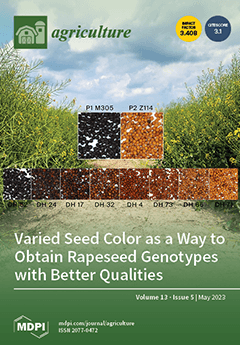Fourteen lactic acid bacteria (LAB) strains were isolated from the intestinal tract and feces of piglets. Among these isolates, only twelve were biochemically (API 50 CHL and ABIS online for bacterial identification) and genetically (16S rRNA sequencing) confirmed as
Limosilactobacillus fermentum,
Lactobacillus
[...] Read more.
Fourteen lactic acid bacteria (LAB) strains were isolated from the intestinal tract and feces of piglets. Among these isolates, only twelve were biochemically (API 50 CHL and ABIS online for bacterial identification) and genetically (16S rRNA sequencing) confirmed as
Limosilactobacillus fermentum,
Lactobacillus acidophilus, and
Lactiplantibacillus plantarum. Experiments to evaluate the probiotic potential of the isolates including pH tolerance (pH 2.0 and 3.0), bile salts (0.3% ox gall) resistance, hemolysis activity, antibiotic susceptibility, and high-temperature resistance were tested. Only two isolates from identified strains exhibited high survival rates when exposed to low pH and bile salts, these were
L. acidophilus IBNA 76 and
L. plantarum IBNA 84. The antibiotic test presented 100% resistance of both strains to gentamicin, kanamycin, lincomycin, colistin sulfate, erythromycin, amikacin, oxytetracycline, enrofloxacin, streptomycin, and tilmicosin, lower than the 0.6 mm inhibition zone diameter. Promising isolates (
L. acidophilus IBNA 76 and
L. plantarum IBNA 84) were exposed to the spray-drying technique based on visible probiotic potential and survival rates. Carrier matrix material was used as a maltodextrin-glucose solution. The encapsulation probiotic isolated survived both over 67% and 77%, corresponding to a decrease in strain viability from 10
9 to 10
7 CFU/g. After further in vitro evaluations, the findings of this study showed that, from all LAB strains,
L. acidophilus IBNA 76 and
L. plantarum IBNA 84 may be considered probiotic candidates for animal nutrition and may have promising performance in piglet feed due to their origin of isolation.
Full article





